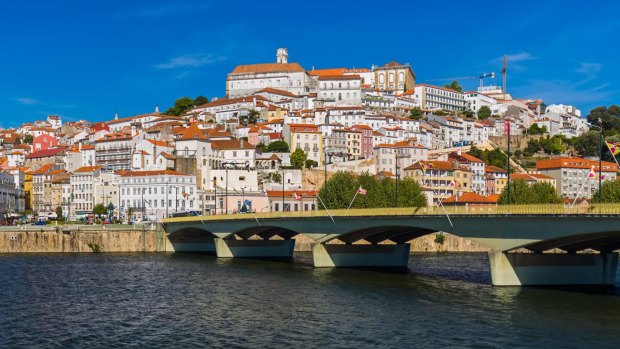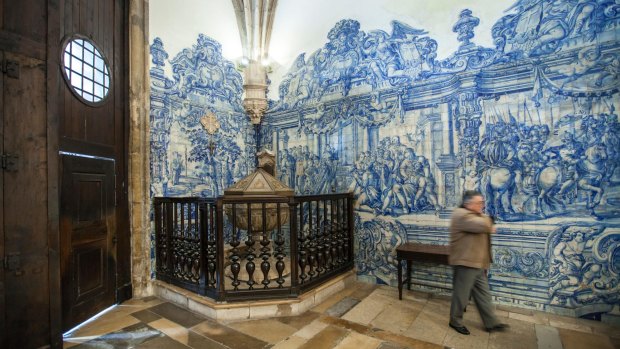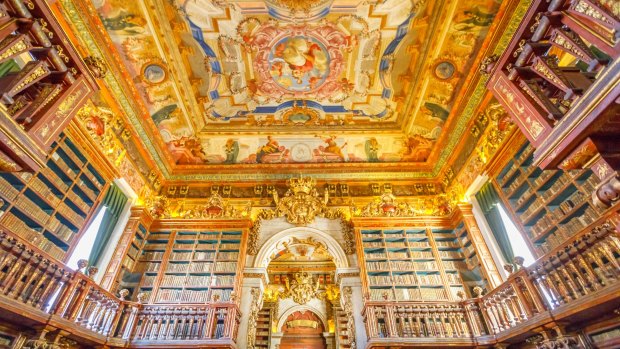This was published 6 years ago
Coimbra, Portugal: Beautiful the first time, perfect the next
By Alison Stewart

The ancient and photogenic town of Coimbra in Portugal.Credit: Alamy
Long ago, two young travellers heading north from Portugal's Algarve entered a mountainous landscape, green with pine and chestnut trees, threaded with rivers, and discovered a hilltop town on the east bank of the Rio Mondego.
What my friend and I happened upon was a ravishing artwork of a medieval town, humming with energy, politics and music. The university town of Coimbra, between Lisbon and Porto, was so lovely it hardly seemed real.
A group of Portuguese students in Harry Potter capes befriended us, pleased to show us their university. We listened to our new friends addressing political issues in the Praca da Republica, ate unrivalled sardines, octopus and roast suckling pig, and frequented bars playing the unique Iberian lyric style, Coimbra fado, performed with traditional guitarra de Coimbra.

Azulejos tiles at the Santa Cruz Monastry at the University of CoimbraCredit: Alamy
Eventually, we had to leave.
To return to a place bearing such memories can be fraught. What once gleamed can appear dusty and diminished. But Coimbra's continuing vibrancy only burnishes those memories.
Perhaps Coimbra's inclusiveness is due to its culture, its reputation enhanced by being Portugal's medieval capital for more than 100 years. Perhaps it's the presence of Portugal's greatest and most prestigious university, dating from 1290, once the seat of Portuguese royalty, and then a crucible for the emergence of rationalism, creative thinking and scientific progress.

The books at Joanina Library are protected from insects by a colony of tiny bats. Yes. Really.Credit: Alamy
Then there's Coimbra's beauty, observed in the chiaroscuro of winding cobbled streets, the dreamily tinted, two-storey sobrado houses with their delicate balconies, the way the city tumbles from the older Alta or upper town with its university crown, to the lower town or Baixa on the river. Whatever it is, the enthusiasm evident all those years ago remains evident today.
Our Airbnb host, Marcelo, a graduate of the university, insists on transporting us from the station to his spotless rental apartment, filling us in on places to eat, best gelato, best sandwiches, best tapas, best bars, best part of the famous botanic gardens, location of the markets, what to see at the university, and even Coimbra's own Romeo and Juliet story.
Marcelo is far from the only affable person in this World Heritage-listed city. It's the start of the academic year and students descend to the town dancing, singing, playing music, and sweeping up passers-by. Onlookers engage us in conversation – people who once attended the university and are back to visit, or to join their student offspring, or just because they love the place.
Our visit begins with the Santa Cruz Monastery, where the first two kings of Portugal are buried.The original Romanesque monastery, founded in 1131 outside Coimbra's walls, has been rebuilt in the Manueline style. Blue-and-white Azulejos tiles line the church, chapel and serene cloister.
Marcelo has recommended Nata, on the main, pedestrianised Rua Ferreira Borges, for its excellent coffee, pasteis de nata, and sardine-and-roasted-red-pepper sandwiches. The nearby Arch of Almedina is the only remaining entrance gate to the original city and an example of Coimbra's Moorish architecture. Just beyond the arch is a "Ginjinha Point" where those heading up the Backbreaker – the Rua Quebra Costas – towards the university fortify themselves with a little glass of this sour cherry liqueur.
We pass Se Velha, Coimbra's 12th-century cathedral and a fine example of Portuguese Romanesque architecture. The heart of the university is Paco das Ecolas or University Patio. It's Coimbra's pinnacle with views down to the Mondego. The plaza is surrounded by a skirt of history that includes the World Heritage-listed 300,000-volume Joanina Library, dating from 1290, with its sumptuous frescoed ceilings, gilt Chinoiserie bookshelves and colony of live, insect-eating bats guarding the books.
There's the 17th-century clock tower, the Royal palace of Alcacova, which has housed the university since 1537 and the 16th-century St Michael's Chapel, built over a 12th-century chapel in decorative Manueline style. It features gorgeous 17th-century ceiling painting, an aisle with Lisbon tiles that resembles carpet and a working baroque 2000-pipe organ decorated with Chinese motifs.
From the Academic Museum, stroll down through the university's 13.5-hectare Botanical Garden, created in 1772. Across the Ponte de Santa Clara from Coimbra's main Largo da Portagem, you'll find the former royal estate of Quinta das Lagrimas (Estate of Tears), where Portugal's Romeo and Juliet story unfolded.
Pedro, son of King Alfonso IV, married for strategy not love, then fell in love with the radiant Ines de Castro. Long story short, the king had her murdered. The Quinta's grounds are filled with allusions to the star-crossed lovers, including the "Pipe of Love". If two people drink simultaneously, their love will be everlasting. My beloved creaks down on one knee to sip the mystical waters but I'm afraid he was alone in this endeavour. There's a fountain the stones of which are apparently stained with Inez's blood and other whimsical reminders of the lovers, now united. Pedro installed Inez's body beside his own sarcophagus in Alcobaca Monastery, an hour south of Coimbra.
Coimbra offers so much more. There's the Passaporte Lounge Terrace for drinks, with its view across the Mondego, the hidden gem of Ze Manel dos Ossos Restaurant or Restaurant Solar do Bacalhau. We end our visit with a terrific meal at Tapas nas Costas. Marcelo has advised booking – tables are like hen's teeth. This is tapas on steroids so order wisely – we devour the lamb with almond and honey, sauteed octopus, garlic prawns with eels and excellent Terra a Terra Reserva Douro red that tastes of the pleasure of returning to a place of fine memories.
Alison Stewart travelled at her own expense.
Trip Notes
FLY
Singapore Airlines flies daily to Amsterdam from Sydney and Melbourne. See singaporeair.com. Various airlines including KLM and Transavia connect to Porto for the 1hr 20-minute train trip to Coimbra B station. See raileurope.com.au
STAY
Marcelo's Loft (about $56 a night) is centrally located in historical area. See airbnb.com.au/rooms/8865512
Sign up for the Traveller Deals newsletter
Get exclusive travel deals delivered straight to your inbox. Sign up now.